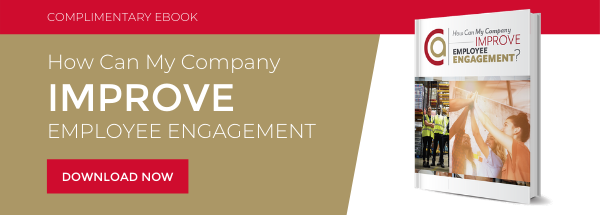Disengaged workers are not good for business and end up affecting their organization's bottom line, and in the larger scheme, they cost the U.S. economy $350 billion annually in lost productivity. Many of these employees have a way of maintaining a bad attitude and infecting others with it, bringing down camaraderie and team morale.
There are degrees of disengagement, so not all disengaged employees behave like a rebel without a cause, but they often resist or refuse to mindfully practice employee engagement with managers and team members, which makes things difficult enough.
The contrast between engaged and disengaged employees is often stark, and unfortunately, engaged employees are outnumbered, being a mere 35% of the workforce, according to a 2019 Gallup tracking report. With their smaller numbers and distinctly upbeat and positive personalities and outlooks, employers know an engaged employee when they see one. They want to see more of them.
Read on to learn what engaged employees do differently.
What Is Employee Engagement?
Some might think that employee engagement is the same as employee satisfaction. While employers want to ensure employee satisfaction, it is a different animal from engagement. Employee engagement is an upbeat and energetic relationship between employees and management, sparking positive behaviors and outcomes for everyone.
Employee engagement is an employee's ability to come to work and remain present, focused, and energized throughout the day, pitching in and offering insights in a welcoming environment. These employees readily go above and beyond standard expectations because their employer has created a culture that allows them to feel like they are part of a purpose bigger than themselves. That sense of purpose lies at the foundation of engagement and drives it.
How Does Employee Engagement Increase Productivity?
Engaged employees offer an organization multiple benefits, and increased productivity is chief among them, along with improved safety, lower absenteeism, higher retention, and better customer service. Productivity, however, is a concrete expression of all of those benefits combined. When an organization has a workforce populated with positive go-getters and self-starters, their worries over meeting deadlines decrease, making way to encourage employees to focus on the big picture with the understanding that each deadline is a benchmark toward overall success for everyone.
While disengaged workers outnumber engaged workers, those engaged clearly offer much more to organizational productivity through sheer positivity and determination.
Who Is Responsible for Employee Engagement?
In short, everyone is responsible for employee engagement. From the company's executives, HR team, managers, and employees, it is everyone's job to develop and foster positive engagement to advance the organization's goals.
Management
While all of these parties are crucial for engagement success, managers play one of the most vital roles. Employees need boots-on-the-ground inspiration and support that only a manager can provide. Well-structured management provides employees with a positive model that allows everyone to play a part, allowing each voice to be heard, and each milestone acknowledged.
Managers are privy to organizational leaders' overriding goals for the company and are tasked with controlling the environment and culture of the business. Managers can take the executive team's goals and enact them with their employees, setting up a framework for success. Managers who work directly with employees can greatly affect motivation in leading by example and offering meaningful and sincere support daily.
Employees
Employees also play a vital role and can pitch in to advance the process by:
- Creating an engaging environment in their immediate area
- Assuming ownership of their work
- Innovating and contributing to the organization any time they can
The Organization
Increasing engagement in the workplace starts with the business. Company leaders must develop a corporate culture focused on creating, fostering, inspiring, and insisting on strong employee engagement. By ensuring engagement becomes interwoven into its vision, employees begin to understand its value and will want to become part of it all, enjoying the positive power of teamwork and goal-oriented workdays.
Human Resources and the Hiring Team
Many times developing an engaged workforce starts with the hiring process. It is easier to foster engagement with people who knowingly signed on to work in such an environment. Hiring leaders need to seek and hire candidates on board and ready to become active participants in their work each day.
How Can an Employer Achieve More Buy-in from Managers?
There are times when employees are less the issue than managers when it comes to promoting employee engagement. Leaders have the power to set the tone, especially managers who work among employees daily. Organizations might wonder how to get more buy-in from managers. Sometimes, it comes down to offering the right incentives in terms of recognition and appreciation to those who improve employee engagement.
Managers who do not buy-in can become as detrimental as disengaged employees, so it is important to try to help them course-correct for their employees and themselves and their careers within the organization.
What Else Can an Employer Do to Improve Employee Relations and Engagement?
Many of today's employers are working to develop strategies for building and improving employee relations and engagement since today's workers yearn for more than a paycheck.
C.A. Short Company can help businesses develop and implement an employee recognition program that gets results. Your business can use it to recognize managers who go above and beyond fostering your engaged environment. We believe that "people are everything" and that you have to reach out to people where they are and help them get on board with your mission. We can help you find a strategy that encourages an all-in outlook for everyone, including your executives, hiring team, employees, and management.
If you have any questions regarding your existing strategies for building and improving employee relations and engagement, or you need suggestions for getting started, we are here for you. Please give us a call or request a consultation with one of our Certified Recognition Professionals.
At C. A. Short, we are your partner for increased employee engagement resulting in increased performance outcomes to grow your bottom line. Our process and research-based platform help you engage your team in order to increase your bottom line, motivate your staff to the benefit of the entire organization, and reward your people for the positive changes they make. To request a Complimentary Consultation, please click here.

.png)


.jpeg)

.jpg)



SHARE